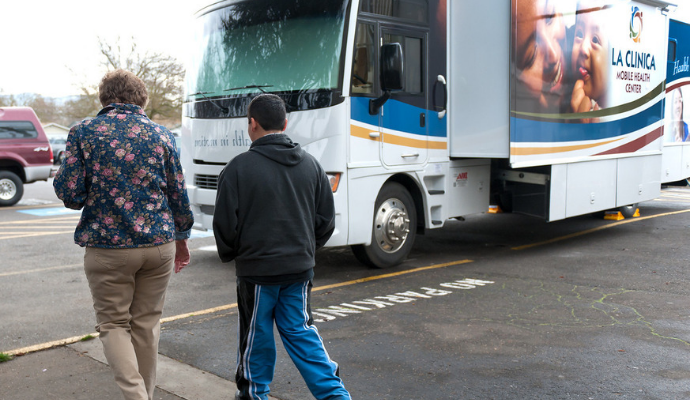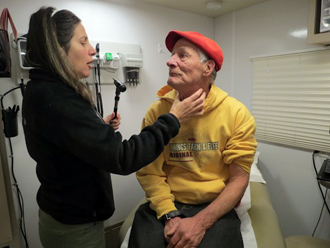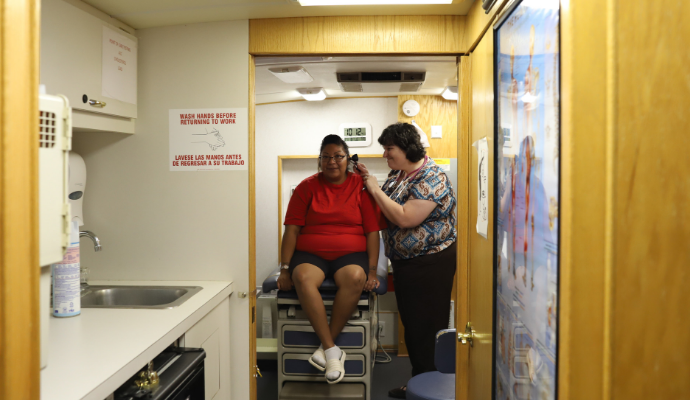
Getty Images/iStockphoto
How Mobile Health Clinics Drive Care to Vulnerable Patients
The mobile health clinic makes a community-based care option for those who otherwise would face extraordinary social challenges accessing care.

In Oregon, patients are queuing to visit with nurse practitioners to get their annual wellness checks, ask about a lingering earache, or receive routine dental care. But these patients aren’t waiting in line at a make-shift doctor’s office. They are in a church parking lot at a mobile health clinic.
Mobile health clinics like the one used by La Clinica in Oregon are becoming increasingly popular, and they have been key for expanding access to care for vulnerable populations.
About 17 percent of patients don’t have a regular place to access healthcare, according to a CDC report from 2016, the most recent year for which the agency has data. This leaves millions of patients without access to necessary preventive or primary care, and the healthcare industry susceptible to costly acute care episodes stemming from irregular health management.
While some of the patients not accessing care may simply be non-adherent to traditional medical advice, in a majority of cases it’s vulnerable patient populations without social supports who are falling by the wayside.
Patients without health insurance, who are low-income, who experience homelessness or housing insecurity, who struggle with substance use disorder (SUD), or who have insecure immigration status face a litany of care access barriers that can be hazardous to patient health.
Because these populations are traditionally marginalized, they may struggle to navigate the medical industry, lack the social support to get to a doctor’s office, be untrusting of the medical establishment, or simply not be able to afford healthcare at a brick and mortar clinic.
Decades ago, mobile health clinics came on the scene to deliver affordable or no-cost healthcare to these vulnerable populations. By bringing healthcare into the community, mobile health clinics have effectively filled in care gaps among migrant workers, patients experiencing homelessness, low-income patients, or others who have been marginalized in traditional institutions.
“We learned early on and from our history that our focus needed to be on those individuals who we knew wouldn't come to our clinics, no matter how much outreach we did to them,” Edward Smith Burns, the outreach director at the Oregon-based La Clinica, said in an interview.
The same issues pervade healthcare today, even after the Affordable Care Act (ACA) and other health reforms have sought to expand healthcare access. Marginalized populations nonetheless face extraordinary barriers to care, while even those with some form of insurance face astronomical healthcare prices that discourage them from accessing primary care.
“We see challenges even after the ACA and a lot of individuals getting onto some kind of insurance,” said Ravi Grivois-Shah, MD, who is the medical director for the mobile health clinic at the University of Arizona. “There's still a lot of individuals who lack access or who lack insurance, whether it's because of recent immigration or immigration status, or because they're transitioning jobs and lose insurance and can't afford COBRA, or they just started a new job.”
By building health clinics inside of a van, La Clinica, UA Health, and other mobile clinics like them have been able to bring care directly to the patient, establishing a sense of trust among patients and community members and beginning to revolutionize the way certain populations manage their health.
Making a difference with vulnerable patient populations
Understanding the community around them and how patients may struggle to access care has been the bedrock of the mobile health clinic program at La Clinica, which established community health centers in 1989 to serve Oregon’s migrant farmworker population.
Since then, the key populations served include a number of demographics, Smith Burns explained.
“There are three populations that we focused on that are considered marginalized or vulnerable in our community, including the homeless population, the migrant seasonal workers that work in agriculture in our county, and then individuals who are living in subsidized housing,” he said.
Each of these populations faces a different barrier to care, Smith Burns continued. For homeless people, a lack of trust and sense of belonging in the medical center is a central issue. Migrant or seasonal workers usually face language barriers that make it harder to access care, while low-income individuals or those living in subsidized housing might lack transportation to care.
La Clinica worked to identify these high-needs populations to target their interventions, ultimately making a dent in patient care access. The clinics serve 86,000 residents in the Jackson County area, the provider reports, with 77 percent of them qualifying as low-income and receiving some subsidized healthcare services.
Forty percent of La Clinica’s patients are insured on the Oregon Health Plan, while 41 percent have no insurance at all, and 8 percent have Medicare.
This kind of impact is reflective of mobile health clinics across the country. According to the Mobile Health Map, a collaborative research network looking at the impact of mobile health clinics across the country, nearly 6.5 million mobile visits happen every year.
Sixty percent of those visits are with uninsured patients, while 31 percent of patients have some type of public insurance. Forty percent of patients are Latinx or Hispanic while 30 percent are black. Forty-two percent of patients are under age 18 and 57 percent are women.
Mobile health clinics have also yielded considerable cost savings, Mobile Health Map reports. The healthcare industry saves $12 for every $1 spent in a mobile health clinic setting. Delivering primary care out in the community also prevents 600 emergency department visits every year, which is a cost reduction of $200 per avoided ED visit.
Leaning on community health partnerships, mobile health clinics have woven themselves into the fabric of patients’ everyday lives.
Leaning on community partnerships to make connections
Mobile health clinics are making significant strides with patient access to care, but the clinics cannot make these inroads within the community on its own. Creating ties to community groups has remained an essential part of what they do and how they connect with patients, said Grivois-Shah.
“Community partnership gives us a built-in group of individuals who need care,” Grivois-Shah explained. “If we just go to a random site, we can do some marketing and some other things, but it's really hard to build awareness of a program regardless of how important it is in a community or how needed it is. If people don't know about it, then no one's going to come.”
Smith Burns agreed, saying that creating community partnerships helps them – and their partners – ensure patients get all of the social services they need. By identifying other services that their target populations access, the team at La Clinica can predict where their patients will be.
“We identify potential community partners by just being out in the community and knowing where other services are offered,” said Smith Burns. “We know for all of the populations that we serve, meals are important. Clothing is important, hygiene and showers are important.”

For La Clinica’s community specifically, there are several faith-based organizations that provide food, clothing, and showers to key populations. Smith Burns and his team form partnerships with these organizations to put all of their services in one place. When a food shelter opens up for a certain meal, the La Clinica mobile health clinic might also set up in the shelter parking lot.
These partnerships need to be located across a community, Grivois-Shah added. UA works to identify numerous community partners that will be able to create access for a number of key demographics, ensuring nobody falls through the cracks.
“We're at nearly a dozen different sites over the course of a month,” Grivois-Shah explained. “These sites include churches in Tucson, schools throughout Tucson, community centers, and the community food bank. We've partnered with various community organizations that have a strong name reputation and pull in the community such as organizations working in HIV care and prevention, homelessness, and youth issues.”
Creating these partnerships is about more than just finding a place to park the mobile health clinic, both Grivois-Shah and Smith Burns pointed out. Fostering a good relationship with community leaders means those partners can help with marketing the clinic.
“For a decade, I've met with the leaders of the church and we talk about how we can use the church, their newsletters, and their marquee out front to help get the word out that we exist and what services we provide,” Grivois-Shah said.
Ultimately, these relationships demonstrate to vulnerable patient populations that they have a place in the medical establishment and that they not only have an imperative to manage their health, but have a right to it as well.
For example, UA has recently partnered with the Southern Arizona AIDS Foundation to improve care for those living with HIV/AIDS. This population can be challenging because of their complex health needs and historical marginalization in healthcare.
By partnering with the Southern Arizona AIDS Foundation and demonstrating their good rapport, UA mobile health clinics can see more patients willing to access healthcare with them, taking the word of an organization that they already trust.
“You see this big van out, you don't know what it does, what kind of services it can provide, or how it can meet the needs that you or your family might have,” Grivois-Shah added. “We've been most successful when we can tap into the built-in clientele or community that our partner site already has to help raise awareness of what kind of services we can provide.”
Establishing trust during the care encounter
Leaning on community health partnerships can help get patients into the mobile health clinic, but it’s key for clinic leaders to create their own rapport with patients to deliver a meaningful care visit, Smith Burns said. To that end, mobile clinics need to demonstrate that patients can rely on them.
“The biggest issue to gaining trust for the populations that we serve is consistency,” Smith Burns said. “When we take our mobile out, we have a schedule and we follow that schedule.”
Of course, there are unexpected roadblocks that can keep the mobile clinic from showing up, Smith Burns conceded. The mobile clinic may have broken down or gotten a flat tire. It’s important that the La Clinica team has an established network of community partners and a vast communication mechanism that can help assuage patient concerns.
“If something unexpected comes up and we're not able to be where we said we were going to be, we have a community network that we rely on to get information out to the community to let people know that there's been a change in our schedule and to let them know where they can find us next,” Smith Burns explained.
Trust also hinges on patients knowing that the clinic is somewhere they belong, Grivois-Shah said. Delivering culturally competent care that takes into consideration patient preferences and language skills is essential for UA.
“We have a number of staff who are Spanish-speaking,” said Grivois-Shah. “And one important way to establish trust is to be able to speak to our patients in their language in a respectful way.”
Mobile health clinic providers should remain mindful of the certain cultural traditions that could influence how a patient interacts with her care. Understanding different signals for respect and culturally relevant strategies for receiving bad news are critical.
Providers should also remain mindful of how patients experiencing serious social determinants of health may interact with the healthcare industry differently and guide their communications based on that. Adopting non-judgmental terminology and considering basic lifestyle needs as a part of the healthcare encounter will be important for making the patient feel as though they belong in the clinic.
Coordinating follow-up care
Even after mobile clinics have established trust, challenges often lay ahead. When a patient needs a referral to more specialized care, providers need to work to coordinate the logistics of that treatment and make the patient feel comfortable accessing it.
Most patients show up to the mobile clinic because they need basic primary care or because they are experiencing what they think will be a minor care need.
But more often than not, providers discover a whole slate of problems a patient is experiencing, some of which they can’t treat inside of the mobile clinic. Providers need to refer the patient to a more traditional care setting, which presents a number of care coordination challenges.
“Typically, the individuals that we serve come to us with an identified need,” Smith Burns said. “Often there is a need for referral or follow-up care. A one way that we address that is that the medical and dental providers that we have on our mobile health unit are actually established in our clinics.”
These providers take time out of their regular schedules in the brick and mortar clinics to go out into the community, making it a little easier to then get patients from the mobile clinic into the community clinic, Smith Burns explained.
“It helps relieve the anxiety that the patient might be feeling about going into an unknown place and not knowing what they're supposed to do or who they're going to see,” he said. “They're reassured that they'll see the same clinician and the same medical assistant will be there.”

But the challenges associated with coordinating community-based care and traditional healthcare are more widespread than that. These patients are going to the mobile clinic because they otherwise can’t get to a traditional doctor’s office, Smith Burns acknowledged, which means the La Clinica team needs to establish social supports that will eliminate any care access barriers.
Community health workers are a boon for this. These professionals help arrange certain services, such as a rideshare for those lacking medical transportation, and generally make the patient feel more comfortable about accessing care in a traditional setting.
“Many of our community health workers have lived experiences of the patients that they're working with, so there's a relatability factor,” Smith Burns noted. “And those community health workers help to establish the referral, and then they help with the communication to remind the patient about the referral.”
Patients being referred for more specialized services stare down another limiting factor: healthcare is expensive.
“That's really a challenge in our community,” according to Grivois-Shah. “We've been trying to work with the community health centers in Tucson that also work with a lot of indigent populations. And I think our community has really struggled with finding some specialized care for patients who don't have insurance or otherwise the ability to pay. This is something we've been really struggling with.”
There isn’t necessarily a great answer to this problem, at least for now, Grivois-Shah said. The UA mobile health clinic has long depended on the goodwill and philanthropy of some community partners, like the Arizona Diamondbacks baseball team, which provided funding for ultrasound machines in mobile clinics’ maternity units.
The clinic has also benefitted from the community service of many providers, like those who volunteer their time to conduct those ultrasounds free of charge.
But that might not be a sustainable model forever, most experts agree, and more must be done to integrate specialty services into the community.
Moving forward into chronic care management
For now, mobile health clinic leaders are taking pride in their ability to serve the community with the means at their disposal. Community-based care has closed the loop for millions of patients across the country through nearly 6.5 million visits last year.
And as clinics look at their footprint over time, leaders are beginning to notice that patients don’t necessarily see these care sites as one-off places to receive treatment. Mobile health clinics may be integrating themselves into the medical home, becoming a trusted place for primary care and even chronic care management.
At La Clinica, this trend presented as 780 patients and approximately 1,400 visits in a one-year span. These figures showed Smith Burns and his team that many patients visited the mobile clinic about twice in a year.
“Initially when we were doing mobile health services, it was a one and done thing. Individuals would come in and we would see them, and then we usually wouldn't see them again,” Smith Burns explained.
But as La Clinica observed more patients coming in for second visits, they saw the power they had in shaping and managing patient wellness, not to mention the business case they are building that may ultimately help chip away at the funding issues they face.
“This indicates to us that there's a growing number of our patients who are actually coming back again and again for services,” he noted. “That's something new for us and something that we're exploring in terms of how we can be more responsive to that and how we can grow that so that people could look at mobile services as a primary care resource for their healthcare.”
Of course, this approach is not entirely realized, and most mobile health clinics still see themselves as a basic means for community-based care. By building trust among patients and working to resolve key care coordination challenges, mobile health clinics have established themselves on the frontlines treating the most vulnerable patient populations.
But as the medical industry prioritizes patient wellness, all while integrating community-based care into the fabric of healthcare, mobile clinics may be facing a new frontier as arbiters of primary and chronic care for key demographics.






